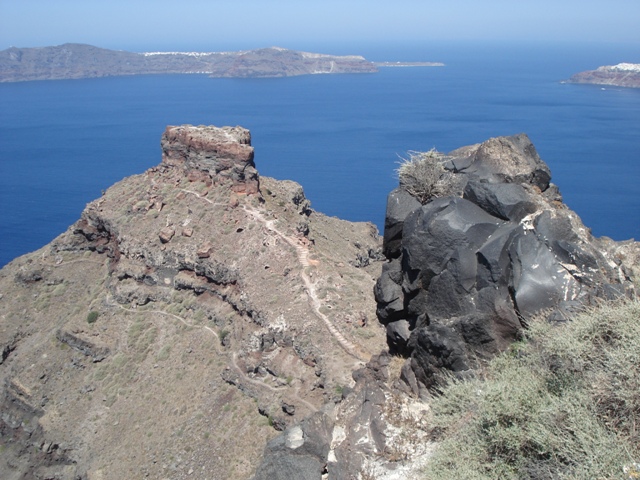Earthquake
Apart from the steams and the hot springs, the volcanic activity is also related to earthquakes caused by the collision between the African and the eurasiatic plates or due to changes in the magmatic chamber. In the case of Santorini, the most serious damages are due to earthquakes rather than the volcanic eruptions. Skaros is a rock in Santorini which had been inhabited in the past and has suffered a lot of earthquakes in the past. This made the habitants to quit Skaros in order to find a safer place to live.

The rock of Skaros in Santorini
The last disastrous earthquake of Santorini took place in July 1956 and was felt by people in areas located 270,000 km away from the focus of the earthquake (in the Aegean Sea, near Amorgos island). Oia and Fira villages were destroyed entirely and more than 50 people died and a lot of buildings collapsed in Santorini and neighboring islands.
Tidal waves
An earthquake that took place in 1649-1650 was followed by a tidal wave that damaged seriously the east side of Santorini. Huge earth masses were washed up in Kamari and Perissa villages, revealing the remains of old churches that had been built at the roots of a mountain.
Tidal waves followed also the earthquake that occurred in 1956, that were possibly due to underground earth-falls near Amorgo island where the waves were almost 25 m high. Three big waves with a speed that reached 60-90 km per second were recorded in that case. They caused innumerable damages to the flooded areas.
Ash falls
Even though the lava flows of a possible volcanic eruption are considered to occur within the caldera, what makes the eruption amazingly dangerous is the ash falls which even make the roofs of the houses collapse. The pumice that lays down the sea causes also great problems to the marine life of a wider area around the volcano.
Earth falls
Areas with rocky mountains or slopes are subject to earth-falls just like Santorini. For instance, the caldera of Santorini consists of various rocks of beds from where huge rock masses may roll to the bottom. Some of them have managed to fall on cave houses which were squashed under the huge weight of the rocks which have also killed many people.
Poisonous Gases
As the magma erupt, various poisonous gases are spread in the atmosphere, in large quantities. Depending on their composition, these gases can be less or more dangerous in some cases. The gases mixes that are released from an active volcano consist of sulphureous and carbonic gases which have an unpleasant smell. The first ones can be seen due to their yellow color smelt yet the second ones are invisible and have no smell so, they are more dangerous as they cannot be avoided by humans. Animals are often poisoned by these poisonous gases which may spread on the ground.
The northern cove of Nea Kameni can be seen from a far distance thanks to the impressive color of the sea water at that area. A thick layer of clay at the bottom of the sea which is composed of volcanic elements (medals) is the reason for which the water has turned to red.
The cove is known as Kokkina Nera and it has been named after the red color of the water. Visitors usually swim in the cove and enjoy bathing in the clay that is considered to be sanatory.
